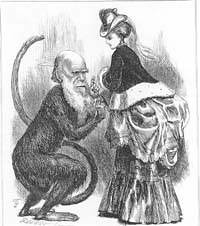A report today identifies two colonies of chimpanzees in a corner of Cameroon as the source of the HIV pandemic, suggesting that are the reservoir of the apparently harmless SIV virus that mutated when a hunter came in contact with chimpanzee blood. What’s particularly interesting is the timeframe:
Researchers believe the virus infected humans some time before the 1930s and was gradually spread by river travel. All of the rivers in Cameroon run into the Sangha, which joins the Congo river running past Kinshasa.
Trade along the routes could have spread the virus, which slowly built up in the human population….
The first clearly identified case of Aids reported in the United States was in 1981, though it seems an African American teenager died of it in St Louis in 1969.
Which does make you wonder how many other such viruses are building up out there. We sometimes think in the West that “modern medicine” understands everything, but as a the victim of a very nasty bug caught in India – variously diagnosed as chickenpox, typhus and “mystery tropical illness”, this last I’m sure the most accurate – I’ve was disabused of that myth.
Turning to more cheerful matters: the great riddle is answered – the egg came first.
Professor John Brookfield, a specialist in evolutionary genetics at the University of Nottingham, who was put to work on the dilemma, said that the pecking order was perfectly clear: the living organism inside the eggshell would have the same DNA as the chicken that it would become.
“Therefore, the first living thing which we could say unequivocally was a member of the species would be this first egg,†he said. “So I would conclude that the egg came first.â€
Seems conclusive to me; an “almost-chicken” produced a chicken.
Somehow, though, I don’t think that will stop the debate, particularly in the pub around about closing time…


 About
About